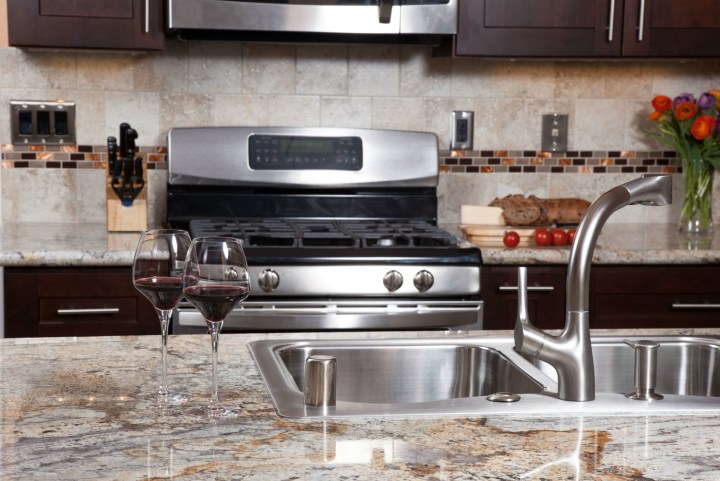
Homeowners who install new granite countertops in their kitchens shell out a pretty penny for the stone, paying between $50 and $100 per square foot for granite slabs. You can purchase a laminate countertop for a fraction of that price, or even create your own faux granite countertop.
Because granite is pricey, and those who have granite counters typically want their kitchens to look their best, granite care and maintenance are key concerns. When your granite counters look in tip top shape, your kitchen looks newer. Your updated kitchen appliances and cabinets will also look much better in a kitchen with shiny, properly maintained granite. If you have granite counters, or you’re considering a kitchen renovation that includes granite countertops, check out our guide that explains the right way to clean and care for granite.
Step 1: Make sure your countertop is properly sealed. Granite countertops are made of natural stone, so each individual slab is unique. Granite is relatively non-porous, and many manufacturers seal slabs before shipping, but you should still reapply sealant periodically. Factory sealants can last for many years, depending on the level of wear and tear. To check and see if your countertop needs sealing, contact your manufacturer or perform a simple water bead test. Drop a few drops of water on your countertop, and if it beads up, your countertop does not need to be sealed. If the water absorbs into your stone or leaves a watermark, you need to seal your counters.
Sealants come in a variety of brands and types, but sealers you can spray onto your counters, like or Stone Care International Stone Spray-n-Seal, are easy to apply properly.
Step 2: Remove stains and water spots. For stains on your granite — rings, dark spots, or oil stains — try using a poultice of baking soda and water (make your paste about as thick as dough). Then, place the paste mixture over the stain. Cover the paste with plastic wrap, and let it sit for 24 to 48 hours. The baking soda may absorb the stain from your counters.
If that doesn’t work, try sprinkling cornstarch directly on top of the stain. Cover it with plastic and wait a few hours. The cornstarch may suck up the remainder of the leftover stain. Some homeowners also swear by these stain removers: Flour mixed with dish soap, rubbing alcohol mixed with water (one part alcohol to eight parts water), baking soda mixed with water and a little bit of hydrogen peroxide, and molding plaster mixed with baking soda.
Step 3: Clean your countertops. Clean your counters with a solution made up of warm water and mild dish soap that does not contain any acidic components (like lemon or citrus scents or extracts). Use a soft cloth to wipe your counters with the soap and water solution, and rinse the cloth frequently while you’re cleaning your counters.
When you finish wiping your counters, dry them completely with a soft cloth, so you don’t leave water sitting on them for too long and form a water stain.
Step 4: Buff your countertops. Using a dry microfiber cloth, buff your counters daily. You can also apply a granite polish, like or , to periodically to make your counters really shine.
Tips
- For regular daily cleaning, you don’t need to purchase a specialty granite cleaner. You can if you want, but it is not necessary. Soap and water will do the trick, and it’ll save you a bundle of money.
- Avoid using bleach, ammonia, scour pads, or any other harsh, abrasive, or acidic cleaner on your granite countertops.
- Use cutting boards, coasters, and placemats to help prevents food stains, rings, and discoloration. Granite can stain if you let foods or liquids sit on it, especially things that contain oil (like pastry dough or lotion) or foods and liquids that contain bright-colored dyes (like popsicles). No one wants stains on the countertops in their big, beautiful updated kitchen.


